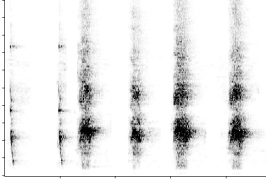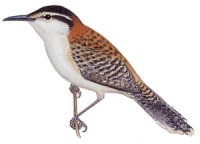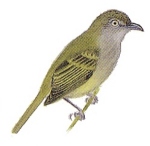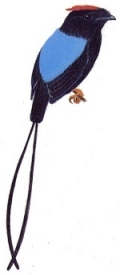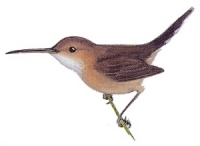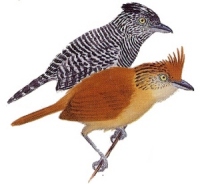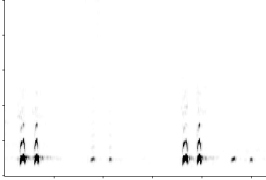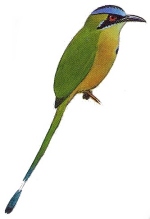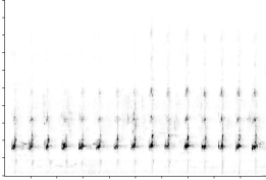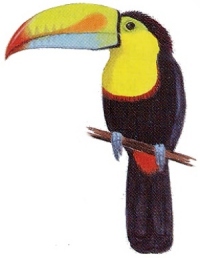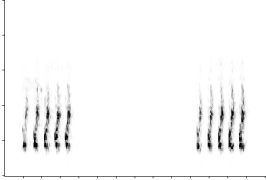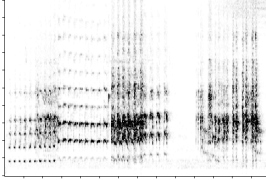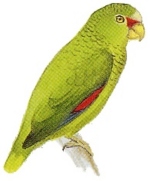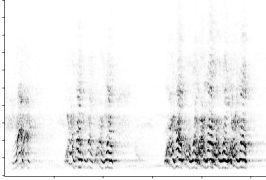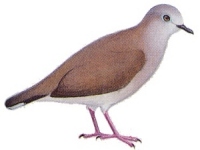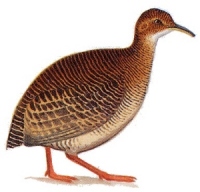  |
||
 Scroll down to explore recordings of more than 23 bird species from Santa Rosa National Park |
||
|
|
||
| Clay-coloured
Robin Turdus grayi Song description The Clay-coloured Robin's song is typical for a robin, consisting of a rollicking series of very melodious phrases. These plain-looking birds have a pronounced dawn chorus and often continue to sing for very long song bouts. Song bouts are comprised of series of two to twenty phrases with short pauses between each series. In the first half of the sound file presented here, you can hear a one-minute song bout. Clay-coloured robins also sing a loud, diagnostic alarm call. The alarm call is a loud whistled note which rises in pitch. It is easy to imitate and you can attract Clay-coloured Robins by mimicking this call. You can hear a series of seven alarm calls at the end of the sound file. Habitat and status Clay-coloured Robins are common permanent residents of Santa Rosa. They can be found in both the dry forest and, less often, in the humid forests. Further reading Clay-coloured Robins form monogamous social partnerships for raising offspring. However, like many songbirds, female Clay-coloured Robins often copulate with males other than their breeding partner! In an interesting study of Clay-coloured Robin mating strategies, Bridget Stutchbury, Eugene Morton, and their colleagues found that extra-pair young are found in almost half of the nests they sampled in a study population in Panama: Stutchbury BJM, Morton ES, Piper WH. 1998. Extra-pair mating system of a synchronously breeding tropical songbird. Journal of Avian Biology 29:72-78. |
 The sound file is 76 seconds (602 kb). The first bout of song plus the first two alarm calls from the sound file are shown above. 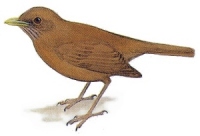 Drawing by Dana Gardner From A Guide to the Birds of Costa Rica |
|
|
|
||
| White-throated
Magpie-Jay Calocitta formosa Song description White-throated Magpie-Jays are very vocal and very social animals. Their voice is extremely variable and includes harsh scratchy sounds, quick chirps, high-pitched screams, and cool "phaser-beam" sounds. The sound file presented here gives you a taste of the impressive repertoire of White-throated Magpie Jays Habitat and status White-throated Magpie-Jays are common permanent residents throughout Santa Rosa. They nest in the dry forest but commonly move into the humid forest. They are usually found in small groups. White-throated Magpie-Jays are likely to find you before you find them! Further reading White-throated Magpie-jays are cooperative breeders. At each nest, one breeding pair plus several helpers cooperate to raise offspring. The social behaviour and vocal behaviour of the White-throated Magpie-jay population at Santa Rosa is currently being studied by Jesse Ellis of Cornell University. You can read about the cooperative breeding behaviour of these jays in the following research paper by Tom Langen and Sandy Vehrencamp: Langen TA, Vehrencamp SL. 1999. How White-throated Magpie-Jay helpers contribute during breeding. Auk 116:131-140. (Download free from http://elibrary.unm.edu/sora/) Alexander Skutch wrote an excellent description of the natural history of the White-throated Magpie-Jay, which includes comments on the contexts in which these jays produce different vocalizations: Skutch AF. 1953. The White-throated Magpie-Jay. Wilson Bulletin 65:68-74. (Download free from http://elibrary.unm.edu/sora/) |
||
|
|
||
| Banded Wren Thryothorus pleurostictus Song description Banded Wrens are excellent singers. Songs begin with a series of short hoots and buzzes, followed by a trill of whistled notes, and finishing with a loud terminal syllable. Each male has a repertoire of fifteen to twenty-four song types. In the first part of the sound file presented here you can hear male Banded Wrens sing several different song types. Certain song types are shared between neighbouring territorial males. Song sharing is important during the territorial song duels of Banded Wrens: males will sing the same song type as their opponent to signal aggression towards their opponent! Banded Wrens also produce various alarm calls including short grunts and rattles. At the end of the sound file you can hear a series of snarly Banded Wren calls. Habitat and status Banded wrens are very common permanent residents in Santa Rosa's dry forest. Their loud songs, and their bulky nests in ant-acacia trees, make Banded Wrens easy to find. Further reading The Banded Wren population in Santa Rosa has been studied in detail by Sandy Vehrencamp, Laura Molles, John Burt, Michelle Hall, Anya Illes, and their colleagues. You can read about their research at the following website: http://www.birds.cornell.edu/brp/BandedWren.html You can also read a detailed account of the impressive vocal repertoires and the vocal duels of Banded Wrens in the following paper: Molles LE & Vehrencamp SL. 1999. Repertoire size, repertoire overlap, and singing modes in the Banded Wren (Thryothorus pleurostictus). Auk 116:677-689. (Download free from http://elibrary.unm.edu/sora/) |
 The sound file is 35 seconds (281 kb). The third song in the sound file is shown above. 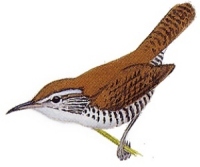 Drawing by Dana Gardner From A Guide to the Birds of Costa Rica |
|
|
|
||
| Rufous-and-white
Wren Thryothorus rufalbus Song description Unlike other species in the Thryothorus wren group, Rufous-and-white Wrens sing very melodious, flute-like songs. Songs begin with a series of one to six introductory syllables, followed by a series of three to thirty-five repeated whistle notes, and finish with a high-pitched terminal syllable. Both male songs and female songs share these characteristics. Each bird has a repertoire of three to fourteen different song types, and you can hear several different song types in the sound file presented here Rufous-and-white Wrens coordinate their songs to create vocal duets. Mated pairs of males and females sing together simultaneously to produce these fascinating pair displays. The second half of the sound file presented here contains several Rufous-and-white Wren duets. You can learn more about Rufous-and-white Wren duets at my Rufous-and-white Wren Page. Habitat and status Rufous-and-white Wrens are common permanent residents of Santa Rosa, but they are only found in the humid evergreen forest. Although sparsely distributed in Santa Rosa, Rufous-and-white Wrens are thick as thieves elsewhere in the Guanacaste Conservation Area, especially at Rincon de la Vieja National Park. Further reading You can read about the similarities and differences in the singing behaviour of male and female Rufous-and-white Wrens in the following paper: Mennill DJ, Vehrencamp SL. 2005. Sex differences in singing and duetting behavior of neotropical Rufous-and-white Wrens (Thryothorus rufalbus). Auk 122:175-186. (Reprint available through my publications page). (On my Rufous-and-white Wren Song Page you can hear each of the songs that are presented in this paper.) |
 The sound file is 52 seconds (415 kb). The first solo song and the first duet in the sound file are shown above. Listen to more songs at my Rufous-and-white Wren Page 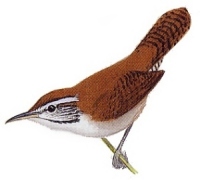 Drawing by Dana Gardner From A Guide to the Birds of Costa Rica |
|
|
|
||
| Plain Wren Thryothorus modestus Song description Plain Wrens sing explosive songs consisting of loud stoccato notes which they utter very rapidly. Breeding males and females sing remarkably coordinated duets. Males and females sing duets by alternating songs back and forth with such precision that their duets are often mistaken for the song of just one bird! Males initiate duets by singing quiet, high-pitched notes, as is common in many other species in the Thryothorus wren group. Plain Wrens exist on both the Pacific slope and the Caribbean slope of Costa Rica. Many ornithologists consider the Caribbean birds to be a distinct species Thryothorys zeledoni: "Canebreak Wrens". Habitat and status Plain Wrens are common permanent residents throughout Santa Rosa and most of the Guanacaste Conservation Area. Unlike the Rufous-and-white Wrens, which are restricted to humid forest, Plain Wrens can be found in both humid forest and adjacent dry forest. Further reading The songs of Canebreak Wrens from the Caribbean slope of Costa Rica have been studied in detail by Peter Slater, Nigel Mann, and Lorraine Marshall-Ball. You can read more about Plain Wren duets in the following paper: Mann NI, Marshall-Ball L, Slater PJB. 2003. The complex song duet of the Plain Wren. Condor 105:672-682. |
The sound file is 36 seconds (288 kb). The first song in the sound file is shown above. Listen to more songs at my Plain Wren Page 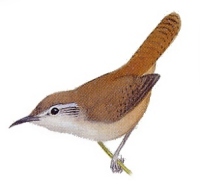 Drawing by Dana Gardner From A Guide to the Birds of Costa Rica |
|
|
|
||
| Rufous-naped Wren Campylorhynchus rufinucha Song description Rufous-naped Wrens sing long, rollicking songs composed of a repeated series of up-sloped and down-sloped whistles. Rufous-naped Wrens sing duets, but they also perform group-choruses involving three or four individuals! The sound file presented here begins as a solo, which turns into a duet, and ultimately builds to a chorus involving three birds. Birds perch very near to each other as they duet and often accompany their songs with body postures that include tail-fanning and head-bobbing. Habitat and status Rufous-naped Wrens are common permanent residents found everywhere in Santa Rosa's tropical dry forest. In the beach towns of Guanacaste province, Rufous-naped Wrens are bold and social animals. In Santa Rosa they are more reserved, although they are easily observed around their large, bulky nests. Further reading You can read more about Rufous-naped Wrens in the species account by Haven Wiley in Daniel Janzen's book Costa Rican Natural History (page 558). |

The sound file is 74 seconds (583 kb). The first bout of song in the sound file is shown above. |
|
|
|
||
| Northern Bentbill Oncostoma cinereigulare Song description The Northern Bentbill sings a simple song consisting of a slowly-descending purr. These buzzy songs sound like a firecracker heard from a distance, but much quieter of course. Northern Bentbills belong to the group of songbirds known as sub-oscines. Unlike oscine songbirds that learn songs from their parents, song is thought to be innate among sub-oscine songbirds like the Northern Bentbill. It is likely that young bentbills can sing a normal song without ever hearing a parent sing it! Habitat and status Northern Bentbills are common permanent residents of Santa Rosa. Further reading Almost nothing is known about this common species. Come to Santa Rosa and study the behavioural ecology of Northern Bentbills! |
||
| Long-tailed
Manakin Chiroxiphia linearis Song description Long-tailed Manakins are bizarre creatures that sing a dizzying array of vocalizations. The most common songs are the duets given by pairs of males. These duets sound like the two males are singing the word "toledo". The Spanish common name for the Long-tailed Manakin is Toledo! Pairs of males sing toledo duets incessantly from high in the forest canopy. These duets serve to attract females to the area. The sound file presented here begins with a series of toledo duets. Once a pair of males has attracted a female by singing "toledo" duets, they descend to the forest floor and begin to dance for her. Long-tailed Manakin dances involve two males jumping overtop of each other, leap-frog style. It is an extraordinary sight to watch a pair of brightly-coloured birds with long tail-streamers dancing for a female! As they dance they sing a mechanical churring sound, which you can hear in the second half of the sound file. Learn to distinguish between 14 different kinds of manakin song at my Long-tailed Manakin Page. Habitat and status Long-tailed Manakins may be the most abundant songbird in Santa Rosa. They are found everywhere in the park, but they are especially abundant in the humid forest. Futher reading Read about the development of coordinated male-male "toledo" duets in Long-tailed Manakins in the following paper: Trainer JM, McDonald DB, Learn WA. 2002. The development of coordinated singing in cooperatively displaying long-tailed manakins. Behavioral Ecology. 13:65-69. Stephanie Doucet studies the Long-tailed Manakins at Santa Rosa. You can read about her research on the evolution of brilliant plumage colour in birds at the following webpage: http://www.auburn.edu/~doucest/ |
 The sound file is 56 seconds (440 kb). The first four toledo duets in the sound file are shown above. Listen to more calls at my Long-tailed Manakin Page |
|
|
|
||
| Long-billed Gnatwren Ramphocaenus melanurus Song description The song of the long-billed gnatwren is a long musical trill, although their songs sometimes take on a non-musical "ticking" quality. Well-endowed in the bill department, these small birds often engage in long bouts of singing from the middle forest canopy. Compare the songs you hear in this recording to my recordings of Long-billed Gnatwrens from Mexico at my Bird Songs of the Yucatan Peninsula webpage. Can you hear a regional difference between Costa Rican and Mexican Long-billed Gnatwrens? Habitat and status Long-billed Gnatwrens are fairly common permanent residents of Santa Rosa forests, especially in areas with substantial evergreen vegetation. Further reading The vocal behaviour of Long-billed Gnatwrens needs further study. Their songs are quite variable, they respond very aggressively to playback, and they would make an excellent study organism for a behavioural ecologist! |
||
|
|
||
| Barred Antshrike Thamnophilus doliatus Song description The barred antshrike song is a loud rattle. Within each song, the notes that constitute the rattle speed up and descend slightly in pitch. Songs end with an emphatic and diagnostic higher-pitched terminal syllable. The male and female Barred Antshrike look very different: the male is striped like a zebra whereas the female is a plain brown. However, the voices of the male and female are very similar. Habitat and status Barred antshrikes are common permanent residents of Santa Rosa, found commonly in the humid forest. Further reading You can read more about the ecology of Barred Antshrikes in the species account by Edwin Willis in Daniel Janzen's book Costa Rican Natural History (page 607). |
|
|
|
|
||
| Blue-crowned Motmot Momotus momota Song description Named for the song they sing, the Blue-crowned Motmot's song sounds as much like "whoop-whoop" as it does "mot-mot". They are usually seen as pairs and they are often heard early in the morning. In the sound file presented here, you can hear one Blue-crowned Motmot in the foreground, and another motmot singing in the background. Blue-crowned Motmots frequently alight on an exposed perch and wag their long tails back and forth in a pendulus motion. The behavioural significance of tail-wagging is a matter of much debate: Do motmots wag their tails to communicate with other motmots? Or do they wag their tails to communicate with predators? Habitat and status Blue-crowned Motmots are common permanent residents of Santa Rosa, found in thicker evergreen forest wherever there is a hillside present for them to build a nest burrow. Further reading Troy Murphy studies a closely-related species of motmot, the Turquoise-browed Motmot Eumomota superciliosa. Both Turquoise-browed and Blue-crowned Motmots perform tail-wagging displays. You can read about Troy's research at the following website: http://www.people.cornell.edu/pages/tgm3/ Investigations of the behavioural ecology of Blue-crowned Motmots are badly needed. |
||
|
|
||
| Keel-billed Toucan Ramphastos sulfuratus Song description Keel-billed Toucans sing long bouts of repeated scratchy notes: "quenk quenk" or "quok quok". Their songs are more like a bullfrog's croak than a bird's song. However, what they lack in musicality they make up for in endurance. Keel-billed Toucans often sing repetitious croaks in long bouts from high in the forest canopy. These birds are much easier to find if you are familiar with their croaking song. Habitat and status Keel-billed Toucans are relatively common permanent residents of Santa Rosa's humid forest. Further reading Read Alexander Skutch's description of the natural history of Keel-billed Toucans in the following paper: Skutch AF. 1971. The life history of the Keel-billed Toucan. Auk 88:381-424. (Download free from http://elibrary.unm.edu/sora/) |
||
|
|
||
| Elegant Trogon Trogon elegans Song description Although its plumage may be elegant, its voice is not. The song of the Elegant Trogon is a series of five or six hoarse syllables: "kowr, kowr, kowr, kowr". They repeat this song in long singing bouts with pauses between one cluster of syllables and the next. Males often gather together and call from small to medium-sized groups, typically in the presence of females. Habitat and status Elegant Trogons are common permanent residents throughout Santa Rosa. Further reading You can read about the breeding behaviour of Elegant Trogons in the following paper: Hall LS, Karubian JO. 1996. Breeding behavior of Elegant Trogons in Southeastern Arizona. Auk 113:143-150. (Download free from http://elibrary.unm.edu/sora/) |
||
|
|
||
| Common Paraque Nyctidromus albicollis Song description Common Paraques are nighttime marathon singers. Paraques are named for the songs they sing, although they sound more like "per-wee-oo" to me. Common Paraques remain quiet and camouflaged on the forest floor throughout the day. They emerge soon after sunset and begin to sing from low perches. They will sing all night long if the moon is full! Although any one song is very similar to the next, their songs change subtly but notably over time. Habitat and status Common Paraques are found throughout the dry forest in Santa Rosa. Anyone driving the main road through Santa Rosa National Park after dark (and especially in the very early morning) knows that you have to drive slowly to avoid hitting the abundant Common Paraques. Further reading Learn more about Common Paraques through the species account by Ernest Edwards in Daniel Janzen's book Costa Rican Natural History. On page 590, don't miss the photo of the gut contents of a Common Paraque - a smorgasbord of stink bugs! |
||
|
|
||
| White-fronted Parrot Amazona albifrons Song description This medium-sized parrot is often encountered in large flocks composed of many pairs of individuals. The calls of White-fronted Parrots are loud and scratchy and often uttered as pairs of syllables: "K'Ack k'ack... K'ack-k'ack...". Parrots are often encountered briefly and at a distance. Being able to recognize the voices of the common parrots of Santa Rosa is very helpful. Habitat and status White-fronted Parrots are common residents in the Santa Rosa dry forest. Further reading To find out more, visit the excellent website on Santa Rosa parrots written by Jack Bradbury, Tim Wright, and Kathy Cortopassi. Their website contains photos, detailed descriptions, and sound files prepared by the experts on Costa Rican parrots: http://www.acguanacaste.ac.cr/loras_acg/parrots.home.html |
||
|
|
||
| Yellow-naped Parrot Amazona auropalliata Song description This medium-sized parrot is often encountered in groups of two. The calls of Yellow-naped Parrots are fairly unique and are usually composed of mellow warbles and squawks. According to Paul Slud, Yellow-naped Parrots sound "like a person imitating a parrot". Parrots are often encountered briefly and at a distance. Being able to recognize the voices of the common parrots of Santa Rosa is very helpful. Habitat and status Yellow-naped Parrots are common residents in the Santa Rosa dry forest. Further reading To find out more, visit the excellent website on Santa Rosa parrots written by Jack Bradbury, Tim Wright, and Kathy Cortopassi. Their website contains photos, detailed descriptions, and sound files prepared by the experts on Costa Rican parrots: http://www.acguanacaste.ac.cr/loras_acg/parrots.home.html |
||
|
|
||
| Mealy Parrot Amazona farinosa Song description This relatively large parrot is typically encountered in small groups, typically in thicker humid forest. The calls of Mealy Parrots are loud and grating and fall into two groups: (1) harsh, loud, abrasive calls and (2) variable whistles and squawks. Parrots are often encountered briefly and at a distance. Being able to recognize the voices of the common parrots of Santa Rosa is very helpful. Habitat and status The Mealy Parrot is an uncommon visitor to Santa Rosa, but I have reliably found them in the humid forest during the late dry season and early rainy season. Further reading To find out more, visit the excellent website on Santa Rosa parrots written by Jack Bradbury, Tim Wright, and Kathy Cortopassi. Their website contains photos, detailed descriptions, and sound files prepared by the experts on Costa Rican parrots: http://www.acguanacaste.ac.cr/loras_acg/parrots.home.html |
 The sound file is 33 seconds (264 kb). The first bout of song in the sound file is shown above. 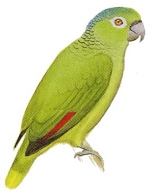 Drawing by Dana Gardner From A Guide to the Birds of Costa Rica |
|
|
|
||
| White-tipped Dove Leptotila verreauxi Song description White-tipped Doves sing a far-carrying "cu-coooo". The first note is very quiet and only audible at close range. Many of the songbirds at the top of this page show a peak in singing at the beginning of the day (the so-called "dawn chorus"). White-tipped Doves, on the other hand, have a peak in singing activity in the warmer part of the day. Although their songs are simple, this dove's sound is highly evocative of warm days in the Santa Rosa dry forest. Habitat and status White-tipped Doves are abundant throughout Santa Rosa and are often flushed off the paths when you are exploring the park's trail system. In flight they display the white outer tips of their tails. Further reading You can read more about White-tipped Doves through the following research papers: Skutch A. 1964 Life histories of Central American pigeons. 76:211-247. Wilson Bulletin (Download free from http://elibrary.unm.edu/sora/) Burger J. 1992. Drinking, vigilance, and group size in White-tipped Doves and Common Ground-Doves in Costa Rica. Wilson Bulletin 104:357-359. (Download free from http://elibrary.unm.edu/sora/) |
||
|
|
||
| Laughing
Falcon Herpetotheres cachinnans Song description The Laughing Falcon is an unmistakable singer, producing one of the most memorable sounds of Santa Rosa. Their calls, which can carry on for up to five minutes at a time, carry for hundreds of meters through the dry forest. This falcon's laughter rivals the Australian Kookaburra's laughter in both length and amplitude. Calls usually begin with some quiet chortling, and then build slowly as repeated singlets or doublets: "gua-co... gua-co... gua-co". (Costa Ricans call the Laughing Falcon "Guaco".) These long bouts of mesmerizing laughter are usually sung as solos. However, pairs of falcons will often sing together to produce laughing duets! Habitat and status These remarkable-looking birds, with their pronounced facial masks, are relatively common in the dry forest of Santa Rosa. Further reading You can read more about Laughing Falcons in the species account by Alexander Skutch in Daniel Janzen's book Costa Rican Natural History (page 582). |
 The sound file is 114 seconds (899 kb). The entire bout of laughing is shown above. 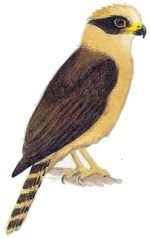 Drawing by Dana Gardner From A Guide to the Birds of Costa Rica |
|
|
|
||
| Roadside Hawk Buteo platypterus Song description Roadside Hawks are noisy and tame birds that are often encountered at close range in Santa Rosa. Their most common vocalization is a downslurred "kweeer", which can be heard at the beginning and end of the sound file presented here. Roadside Hawks also produce a very different vocalization during the breeding season. It is a long and noisy series of rising "keh-keh-keh..." sounds that are often given by two birds simultaneously. Habitat and status Roadside Hawks are abundant along the roads and trails throughout Santa Rosa. Further reading You can read more about Roadside Hawks in the species account by Gary Stiles and Daniel Janzen in Janzen's book Costa Rican Natural History (page 551). |
 The sound file is 58 seconds (458 kb). The first three calls in the sound file are shown above. 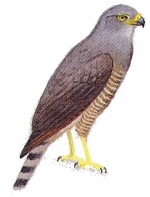 Drawing by Dana Gardner From A Guide to the Birds of Costa Rica |
|
|
|
||
| Crested Guan Penelope purpurascens Song description Crested Guans are large and noisy birds that make a racket as they move around the forest canopy. Their primary calls sound like a series of short blasts through a broken clarinet. These calls are usually given in a sequence that rises and then falls in amplitude. Crested Guans also make a variety of mechanical noises as the fly about the forest. Habitat and status Crested Guans are permanent residents found in abundance throughout Santa Rosa. Further reading You can read an interesting note about Crested Guan distress calls in the following article: Kilham L. 1978. Alarm call of Crested Guan when attacked by Ornate Hawk-Eagle. Condor 80:347-348. (Download free from http://elibrary.unm.edu/sora/) |
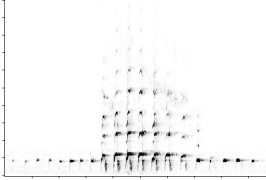 The sound file is 26 seconds (210 kb). The first series of notes in the sound file are shown above. 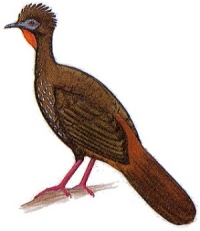 Drawing by Dana Gardner From A Guide to the Birds of Costa Rica |
|
|
|
||
| Thicket Tinamou Crypturellus cinnamomeus Song description The secretive Thicket Tinamou sings one of the simplest song in Santa Rosa's forest, and maybe the simplest song among all birds: a single, plaintive whistle. This resonant whistled note is often exchanged between birds who are separated by a great distance. The Thicket Tinamou's song can be easily imitated and used to attract a tinamou to the observer. Thicket Tinamous sing throughout the day and often continue singing until the middle of the night if the moon is bright. Habitat and status Thicket Tinamous are very common through the dry forest of Santa Rosa, although they are heard more often than seen. Further reading You can read more about Tinamous in the species account by Douglas Lancaster in Daniel Janzen's book Costa Rican Natural History (page 572). |
||
|
All
information on this website is copyright Daniel Mennill 2005 unless
otherwise indicated. No
recordings, photographs, or other information may be used without
written permission from me. Please email me at dmennill AT uwindsor DOT ca
and I will happily grant permission for most non-commercial or
educational
purposes.

|
||
